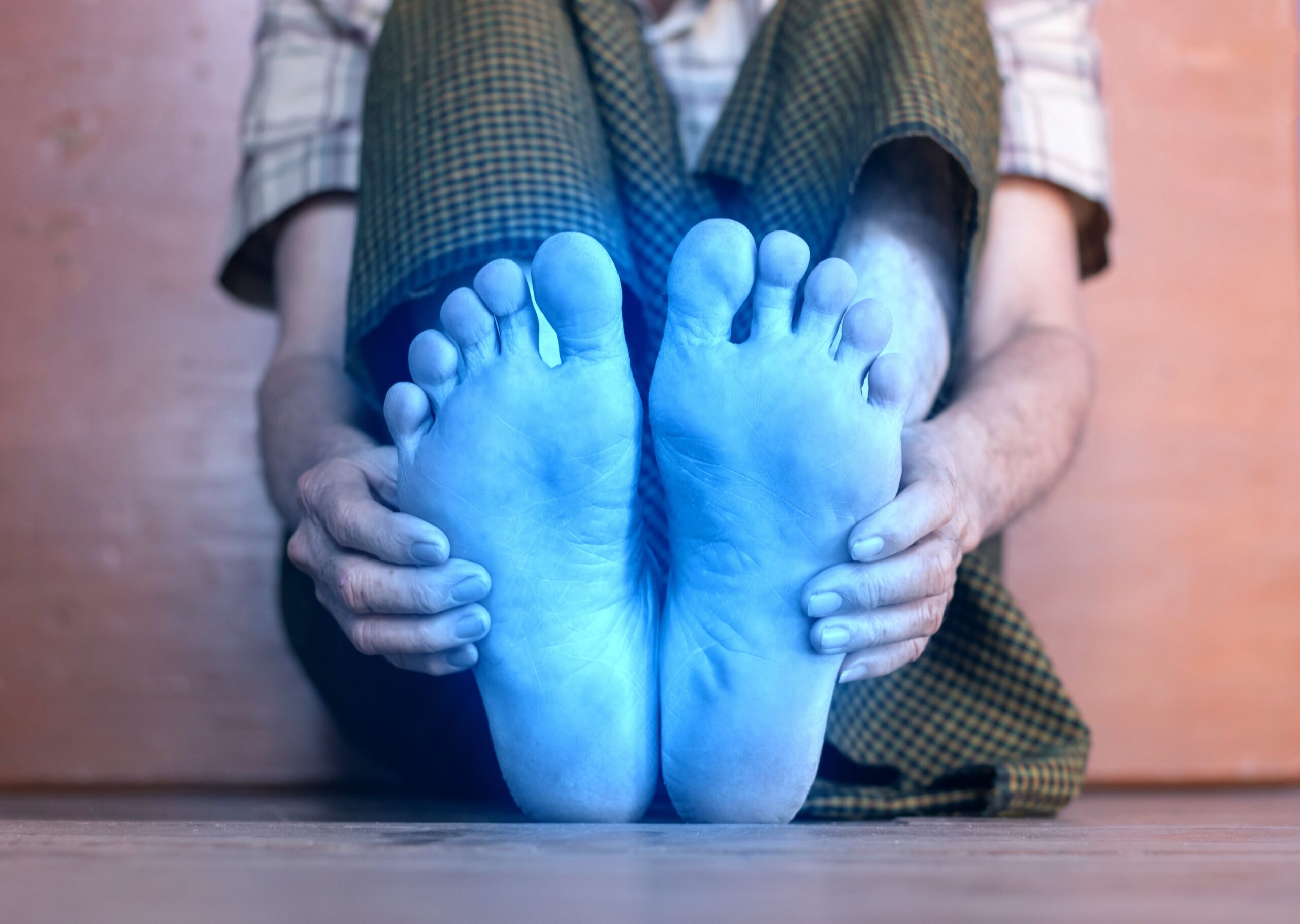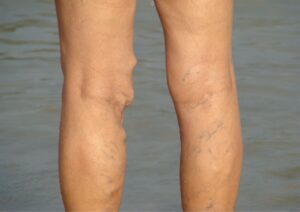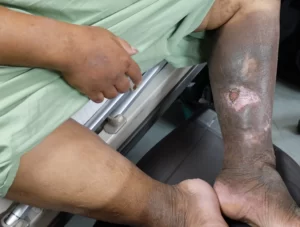Having weak circulation will cause muscle cramping or tingling symptoms. Doctors usually treat symptoms of a poor circulatory system in their patients. The circulation system circulates blood through the body. Symptoms of poor circulation can be seen if the blood flow is reduced to a specific area of your body. It is common in all parts of the body and it will be addressed in this piece in the context of blood flow in or through your hands, feet, legs.
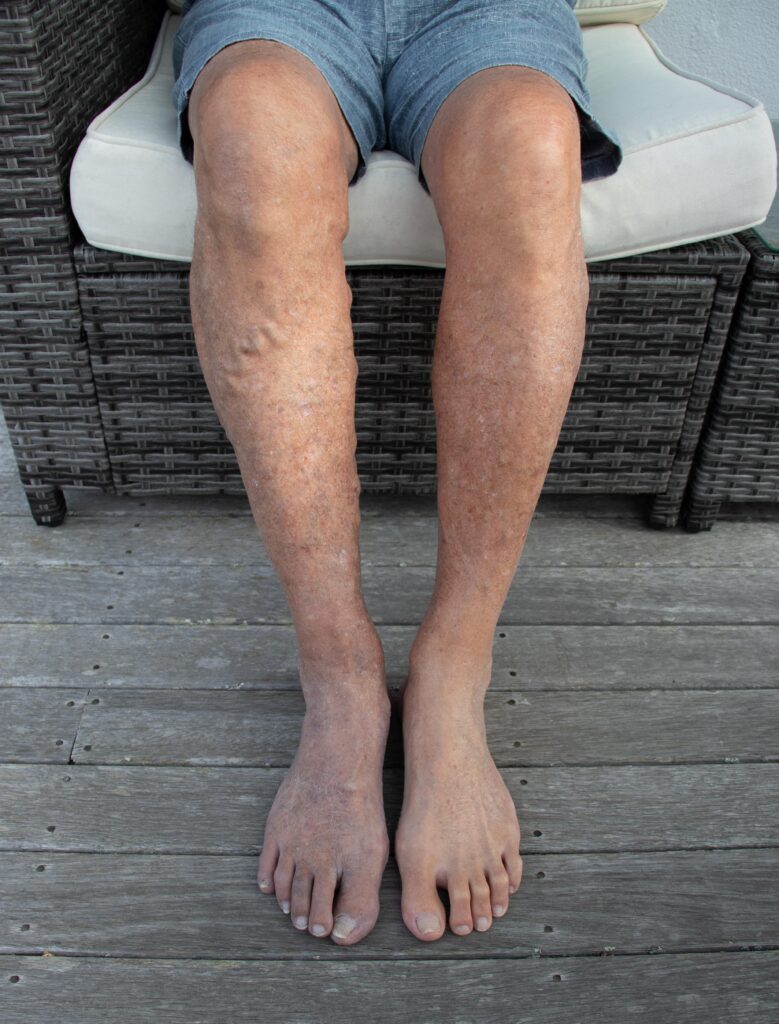
Symptoms of Poor Circulation
Poor circulation can be due to peripheral arterial disease/peripheral vascular disease (PAD) or chronic venous disease. It can affect circulation to the limbs, including the legs, arms, and hands. The following are some of the most common symptoms of circulation disorder:
1. Numbness or tingling:
A lack of circulation to the limbs can cause a tingling or pins-and-needles sensation, especially in the lower extremities. This is often the first symptom of poor circulation.
2. Muscle cramps or pain:
Reduced circulation can cause muscle pain, cramps, or weakness, especially during physical activity.
3. Swelling:
Poor circulation can lead to fluid buildup in the legs, ankles, and feet, resulting in swelling and puffiness.
4. Changes in skin colour or texture:
The skin may appear pale, blue, or reddish in colour and may feel cool or cold to the touch. The skin may also become thin, shiny, or dry.
5. Wounds or sores:
Poor circulation can slow the healing process and make it difficult for wounds or sores to heal, especially on the feet or lower legs.
6. Weak pulse:
In severe cases of poor circulation, the pulse in the affected limb may be weak or non-existent.
7. Erectile dysfunction:
Men with poor circulation or swollen legs may experience erectile dysfunction, as circulation to the penis may be reduced.
It’s important to note that these symptoms may be caused by other medical conditions, and a proper diagnosis is necessary for effective treatment. If you experience any of these symptoms, it’s important to seek medical attention to determine the serious underlying causes that cause just the symptoms and receive appropriate treatment.
How Does the Circulatory System Work?
The vascular system is responsible for the circulation of blood throughout the body, delivering oxygen and nutrients to the cells and removing waste products. The following are the main components of the vascular system and how they work together:
1. Heart:
The heart is a muscular organ that pumps blood throughout the body. It has four chambers: the right and left atria, and the right and left ventricles. The right side of the heart pumps deoxygenated blood to the lungs for oxygenation, while the left side of the heart pumps oxygenated blood to the rest of the body.
2. Arteries:
Arteries are blood vessels surrounding tissues that carry oxygenated blood away from the heart and towards the body’s tissues and organs in sufficient quantities. Arteries have thick walls and are designed to withstand high pressure.
3. Capillaries:
Capillaries are tiny blood vessels that connect arteries to veins. They are where the exchange of oxygen, nutrients, and waste products occurs between the blood and the body’s cells.
4. Veins:
Veins are blood vessels that carry deoxygenated blood back to the heart. They have thinner walls than arteries and have valves to prevent the backflow of blood.
5. Blood:
Blood is a fluid that carries oxygen, nutrients, hormones, and waste products throughout the body. It is composed of red and white blood cells, platelets, and plasma.
The circulatory system works by the heart pumping blood through the arteries, which branch out into smaller arterioles and then into capillaries. In the capillaries, oxygen and nutrients diffuse from the blood into the surrounding cells, while waste products, such as carbon dioxide, diffuse from the cells into the blood. The deoxygenated blood then flows through the capillaries into venules, which join together to form larger veins that carry the blood back to the heart. The heart then pumps the blood back into the lungs to be oxygenated and the cycle begins again.
What is a common cause of poor circulation?
There are several common conditions that decrease blood flow, including:
1. Peripheral artery disease (PAD):
This is a condition in which the arteries stiffen in the legs or arms, becoming narrowed or blocked by a plaque buildup, reducing blood flow to the extremities. PAD is often caused by a plaque buildup in the arteries, which can be a result of smoking, high blood pressure, hypercholesterolaemia or diabetes. It is a cardiovascular disease that can also present with heart attack, reduced blood flow in the carotid arteries and other life threatening complications.
2. Diabetes:
High blood sugar levels in people with diabetes can damage the blood vessels and nerves, leading to diabetic neuropathy and vascular disorder. Those patients are at higher risk of complications of the vascular system that lead to poor circulation.
3. Obesity:
Being overweight or obese can put extra strain on the circulatory system, making it harder for the heart to pump blood efficiently.
4. Smoking:
Smoking can damage the blood vessels and reduce the amount of oxygen in the blood, leading to poor circulation as well as putting the patient at a higher risk for vascular problems.
5. Sedentary lifestyle:
Lack of physical activity can lead to poor circulation, as regular exercise helps to strengthen the heart and circulatory system.
6. Raynaud’s disease:
This is a condition in which the small vessels in the fingers and toes narrow in response to cold or stress, leading to poor circulation, cold hands and numbness or tingling in the extremities.
7. Blood clots:
Blood clots can block the flow of blood through the vessels, so it is important to speak with a doctor or vascular specialist to determine the underlying cause and receive appropriate treatment. Other conditions such as Parkinson’s disease, hypertension, inactive lifestyle, and overweight can also affect blood circulation. Those older than 65 tend to have more inadequate circulation due to their secluded lifestyles.
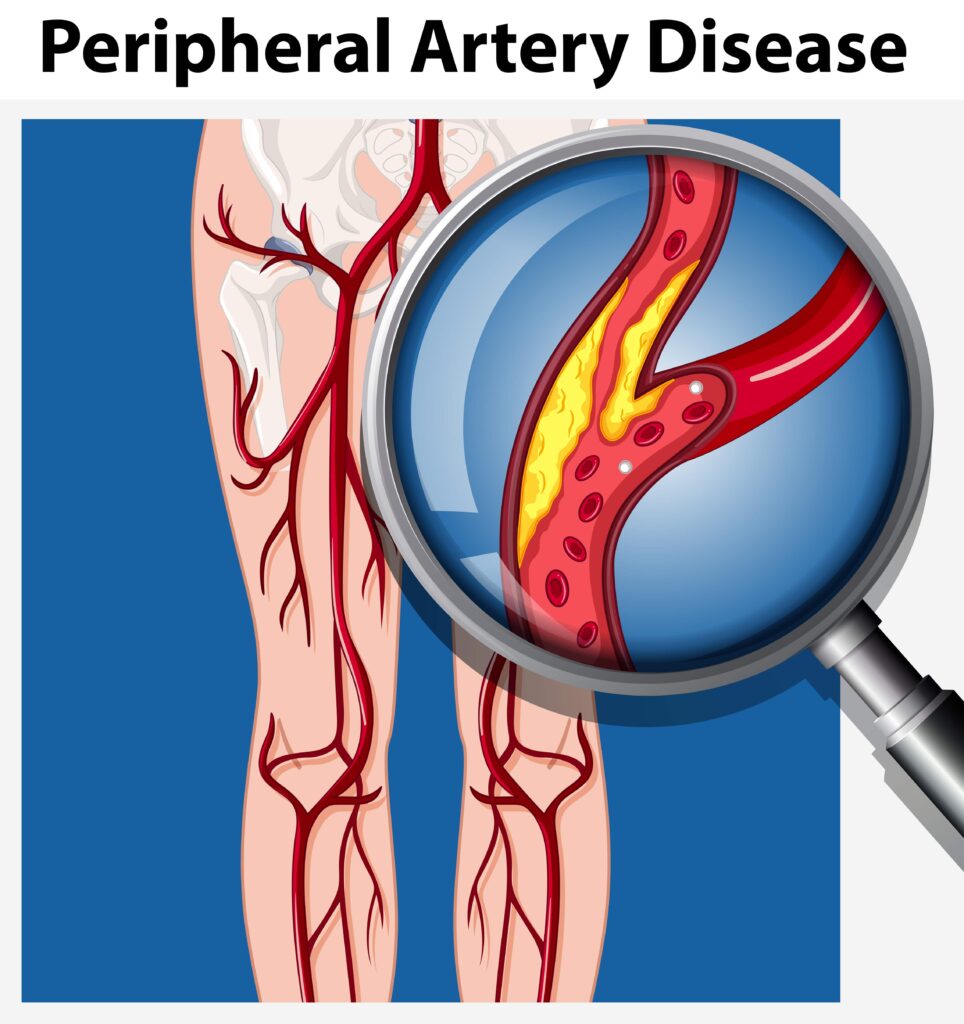
What is Peripheral Artery Disease?
Peripheral artery disease (PAD) is a condition in which the arteries in the legs or arms become narrowed or blocked, reducing blood flow to the extremities. It affects millions of people in the US, particularly those over the age of 50. Symptoms of PAD include pain, cramping, tiredness, numbness, weakness, coldness, and slow-healing wounds. Diagnosis involves a physical exam, imaging tests, and measurement of blood pressure. Treatment options include lifestyle changes, medications, and surgical intervention. If left untreated, PAD can lead to serious complications, such as gangrene, non-healing wounds, and amputation. It is important to speak with a healthcare provider if you are experiencing symptoms of PAD, particularly if you have a history of smoking or other risk factors for the condition.
What are Varicose Veins?
Varicose veins are enlarged, twisted, swollen veins that can be seen just under the surface of the skin. They are caused by faulty valves in the veins, which lead to the characteristic bulging and twisting of the blood vessel. In some cases, varicose veins may be a sign of chronic venous insufficiency, a condition in which the valves in the veins are damaged. Treatment may involve new lifestyle habits, such as exercise and weight loss, wearing compression stockings, and in some cases, surgical procedures. If you are experiencing symptoms of varicose veins, it is important to speak with a vein doctor to determine the underlying cause and receive appropriate treatment.
How to Prevent Poor Blood Circulation?
Preventative measures involve making new lifestyle habits that promote good blood flow and overall cardiovascular fitness. Here are some tips:
1. Exercise regularly:
Regular physical activity, such as walking, cycling, or swimming, can help improve your blood flow and strengthen the heart and vessels.
2. Maintain a healthy weight:
Being overweight or obese can increase the risk of poor circulation, so maintaining a balanced and healthy diet and regular exercise is important.
3. Don’t smoke:
Smoking can damage blood vessels and increase the risk of atherosclerosis, so quitting smoking is important for maintaining good circulation.
4. Manage underlying medical conditions:
Conditions such as diabetes, hypertension, and high cholesterol can all contribute to poor circulation, so it’s important to manage these conditions through medication and healthy lifestyle.
5. Stay hydrated:
Drinking plenty of water and other fluids can help keep blood flowing smoothly and prevent dehydration, which can cause blood to thicken and circulate more slowly.
6. Practice good hygiene:
Good hygiene, including regular hand washing and foot care, can help prevent infections that can worsens any underlying condition.
7. Wear comfortable clothing:
Wearing loose, comfortable clothing and avoiding tight-fitting socks or stockings can help prevent constriction of blood vessels and improve your blood flow.
By following these tips, you can help promote good circulation and healthy blood flow and reduce the many risk factors of developing vascular issues and related complications.
Treatment of Poor Blood Circulation
Treatment plan depends on the underlying cause and the severity of the condition. Here are some common treatments for:
1. Lifestyle changes:
Making changes to your diet, exercise habits, and other lifestyle factors can help improve your blood flow. This may include quitting smoking, maintaining a healthy weight, eating a balanced diet, and getting regular physical activity.
2. Medications:
Depending on the cause, your doctor may prescribe medications such as blood thinners to prevent blood clots, cholesterol-lowering drugs, or medications to manage underlying conditions such as diabetes or hypertension.
3. Compression therapy:
Compression stockings or sleeves can help improve circulation by applying pressure to the legs forcing fluid to be reabsorbed faster in addition to push blood back up toward the heart.
4. Surgery or procedures:
In some cases, surgical or minimally invasive procedures may be necessary to improve blood flow. This may include angioplasty (a procedure to open blocked arteries), bypass surgery (creating a new pathway for blood to flow around a blocked artery), vein stripping (removing damaged veins or blood clots vessel) or endovenous ablation if the patient is presenting varicose veins.
5. Other therapies:
Other therapies such as massage, acupuncture, or hydrotherapy may also be beneficial in improving circulation and reducing symptoms.
Early diagnosis and treatment can help prevent complications and improve overall vascular health.
The most important details in this text are the various vascular problems that can affect the body, such as peripheral artery disease (PAD), venous insufficiency, deep vein thrombosis, Raynaud’s disease, atherosclerosis, and heart failure.
PAD is a condition in which the arteries that supply blood to the limbs become narrow or blocked, causing pain, numbness, and other symptoms in the legs and feet.
Venous insufficiency is a condition in which the veins that carry blood from the legs back to the heart become damaged or weakened, causing blood to pool in the legs and leading to swelling, varicose veins, and other symptoms.
Deep vein thrombosis is a blood clot that forms in a vein deep within the body, typically in the leg, which can cause leg pain, swelling, and other symptoms.
Raynaud’s disease is a condition in which the small vessels in the fingers and toes constrict in response to cold or stress, causing them to turn white or blue and feel numb or painful
Vitamin and mineral deficiencies can have a significant impact on blood circulation, such as iron deficiency anaemia, vitamin B12 deficiency, vitamin D deficiency, and magnesium deficiency.
Iron deficiency anaemia is caused by a deficiency of iron in the body, which can lead to reduced circulation and other symptoms.
Vitamin B12 deficiency is important for maintaining healthy blood cells and nerve cells, and can lead to fatigue.
Vitamin D deficiency can lead to weakened bones and muscles, and magnesium deficiency can lead to reduced circulation and muscle cramps. It is important to maintain a balanced diet and speak with a doctor if you are experiencing symptoms of inadequate blood flow.
Poor circulation can be serious and can lead to various health complications. It can occur due to various underlying medical conditions, such as peripheral artery disease, diabetes, heart disease, or blood clots, and if left untreated, it can cause serious problems.
Some of the complications that can arise from poor circulation include tissue damage, wound healing problems, ulcers, infections, and stroke.
It is important to speak with a medical professional if you are experiencing symptoms of poor circulation, as early detection and treatment can help prevent further complications.

